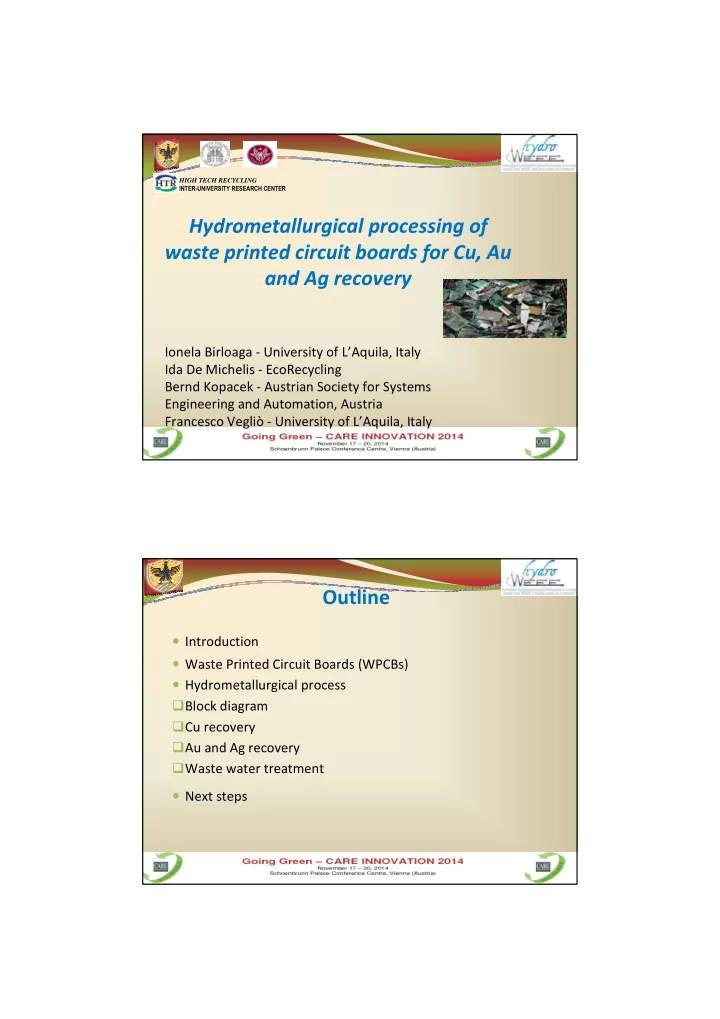

HIGH TECH RECYCLING INTER-UNIVERSITY RESEARCH CENTER Hydrometallurgical processing of waste printed circuit boards for Cu, Au and Ag recovery Ionela Birloaga - University of L’Aquila, Italy Ida De Michelis - EcoRecycling Bernd Kopacek - Austrian Society for Systems Engineering and Automation, Austria Francesco Vegliò - University of L’Aquila, Italy Outline � Introduction � Waste Printed Circuit Boards (WPCBs) � Hydrometallurgical process � Block diagram � Cu recovery � Au and Ag recovery � Waste water treatment � Next steps
Introduction � The WEEE Directive 2002/96/EC was revised by the European Commission and, as result, the new Directive 2012/19/EU was introduced. By this the following collection targets have been introduced: � 45% of the sold electronic equipments (starting with 2016); � 65% of the sold electronic equipments or 85% of e-wastes generated(starting with 2019). � Most of all electronic components present in their structure printed circuit boards (PCB) Current recycling technologies Incomplete separation of Mechanical - Physical elements - pretreatment Pyrometallurgy Hydrometallurgy Biometallurgy High capital cost; loss of Presents more flexibility In the incipient phase byproducts in slags during the upscaling and and residues control processes In early stage and Ionometallurgy relatively high cost of reagents
WPCBs Characterization for recycling o More than 10% of worldwide reserve of Au is used in the manufacturing of electronic devices. o Depending on their gold content, the WPCBs are divided into three categories, namely: • high grade (>200 mg/kg) • medium grade (100<200 mg/kg) • low grade (<100 mg/kg) Economic drivers in WPCBs treatment (Wang and Gaustad, Waste Management, 32 (2012)) WPCBs Structure and their electronic components analysis 1 Al electrolytic capacitors 2 Heat sink- Al 3 Black panel - Steel, plastic and pins (Cu, Au, Al) 4 Inductors - Cu and ferrite 5 Quartz resonators 6 Battery 7 Multi-layer ceramic capacitors (MLCC) (Ag- 9.5 g/kg; Pd - 1.02g/kg; Nb – 13.29%; Ta – 0.49%) 8 Tantalum ceramic capacitors (Ag – 1 %; Ta – 20%) 9 IC chips (Ag – 1 g/kg; Au – 890 mg/kg; Pd – 15 mg/kg)
Hydrometallurgical process Block diagram Preparation and characterization of the WPCBs sample Motherboard with mounted components Removal of a part of Milling to a particle Al base components size of <1mm Chemical analysis of WPCBs sample Cu Zn Al Fe Sn Pb Ni Ag Au Pd % (wt./wt.) mg/kg 20.84 2.79 4.57 2.39 5.11 2.78 0.22 689 306 42
Recovery of Cu Oxidative leaching process Cu + H 2 SO 4 + H 2 O 2 = CuSO 4 + 2 H 2 O Cementation with Zn metal powder Cu recovery >98% are observed at lab scale Au and Ag recovery Thioureation process 2Au + Fe 2 (SO 4 ) 3 + 4SC (NH 2 ) 2 = [Au (SC (NH 2 ) 2 ) 2 ] 2 SO 4 + 2FeSO 4 2Ag + Fe 2 (SO 4 ) 3 + 6SC (NH 2 ) 2 + SO 2- 4 = [Ag (SC (NH 2 ) 2 ) 3 ] 2 SO 4 + 2FeSO 4 Neutralization with sodium hydroxide and cementation with Zn metal powder [Au(SC(NH 2 ) 2 ) 2 ] 2 SO 4 + Zn → 2Au + 4CS(NH 2 ) 2 + ZnSO 4 [Ag(SC(NH 2 ) 2 ) 3 ] 2 SO 4 + Zn → 2Ag + 6CS(NH 2 ) 2 + ZnSO 4 Gold and silver complete precipitation with NaOH at pH 2 and cementation with Zn
Waste water treatment Fenton process Fe2+ + H2O2 → Fe3+ + OH• + OH OH• + Fe2+ → OH− + Fe3+ Unit of Initial After Fenton Final treatment Parameter Leg. It. measure conditions treatment with Ca(OH) 2 pH 2.5 1.9 10 5.5-9.5 TDS g/L 51 28.82 SST g/L 2.6 COD mg/L 11600 2057 520 500 Abatement % 74 94 94 of COD SO 4 -2 g/L 54 45.72 18.62 Abatement % 40.72 40.72 of SO 4 -2 Next steps � Recovery of other valuable elements (on progress) for a better sustainability of the process � Improve of purity level of the outputs � Mobile plant tests
Recommend
More recommend